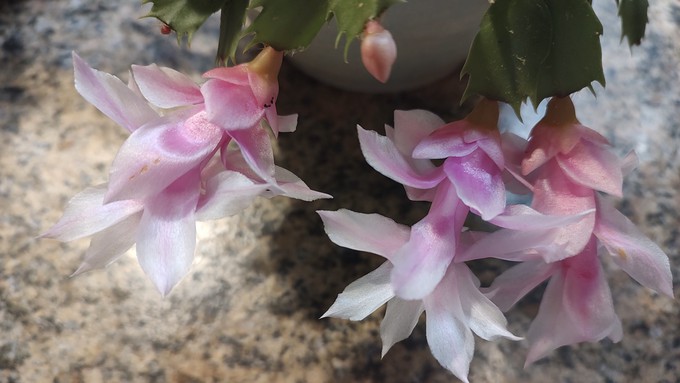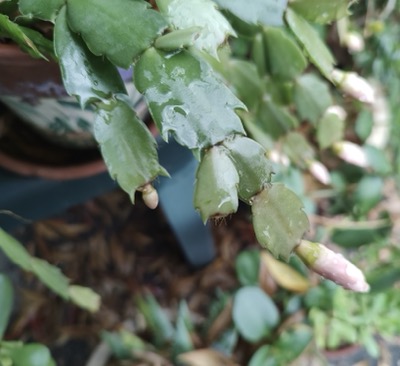
This succulent makes a great gift and can rebloom for many years to come

Most Christmas cactus sold now are hybrids, which come in several colors beyond magenta or white. Debbie Arrington
Cactus for Christmas? In California, Schlumbergera – the Christmas cactus – has become ubiquitous during the holiday season.
According to floral experts, this succulent is the second most popular holiday plant for gift giving, behind only poinsettias. Unlike poinsettias, Christmas cactus are much easier to get to rebloom – and these plants can live more than 100 years.
Like other succulents, they’re easy care, easy to divide and easy to share with friends. That also makes Christmas cactus perfect for the season of giving.
Christmas cactus became holiday stars because they bloom in mid-winter. An epiphyte native to Brazil, these plants grow on moss-covered trees in rain forests. They like indirect light, some humidity and relatively warm temperatures – about 65 to 70 degrees. That makes them an ideal houseplant, too.
Most of the Christmas cactus now selling in nurseries and stores are Schlumbergera x buckleyi; that’s actually a hybrid cross of Thanksgiving cactus and true Christmas cactus species, combining the best traits of each. It has more color possibilities (including Christmas red) than true Christmas cactus while blooming later than Thanksgiving varieties.
Thanksgiving cactus (Schlumbergera truncata), which tends to bloom in November as its name implies, has very pointed claw-shaped projections on the end of its segmented leaves. It also has the widest color range: White, pink, red, peach, purple, orange and combinations. Its flowers tend to point upwards.

True Christmas cactus (Schlumbergera russelliana), which blooms in late December, comes in two hues: Magenta and white. Its flat segmented leaves are the smoothest, with a few notches around the edges. Its long tubular flowers dangle at the end of its long stems, making this an ideal hanging plant.
These two cacti have a close cousin that blooms in early spring: Easter cactus (Rhipsalidopsis gaetneri). When not in flower, it looks very similar to Christmas cactus but blooms later (typically March) and has tiny bristles on the edge of its leaf segments. (It’s the one that most likely will prick your fingers.) Its flowers are star-shaped instead of tubular and very vibrant in shades of white, peach, magenta, pink, red, purple and orange.
Easter cactus bloom last because they need the most darkness to prompt blooms. Thanksgiving and Christmas cactus need about six weeks of short days (with more than 13 hours of darkness), while Easter cactus requires 12 weeks of long nights.
That’s the key to getting these cacti to rebloom year after year: Make sure they get enough darkness (and a little cool) in the early fall. Schlumbergera need exposure to cooler temperatures (55 degrees) as well as darkness to cue its bloom cycle.
The easiest way to assure your cactus doesn’t miss its blooming cues: Put it outside in a shaded, protected spot in summer. Once the buds start to form in November, bring the plant back indoors.
Here are some more tips to keep your Christmas (or other holiday) cactus looking good:
* Treat your cactus much like a poinsettia. These succulents prefer temperatures on the warm side, ideally 65 degrees.

* Make sure its pot has drainage. Poke holes in foil if the plant comes gift wrapped.
* While assuring good drainage, keep soil evenly moist while cactus is blooming, misting it once a day. The flowers appreciate that extra humidity.
* These plants need moderate light to bloom. Place the cactus in an east-facing window so it can get some direct sun.
* But keep it away from heat or drafts; that will cause it to drop its buds.
* To keep this cactus in flower longer, fertilize every two weeks with high-potassium fertilizer designed for houseplants.
Comments
0 comments have been posted.Sacramento Digs Gardening to your inbox.
Sites We Like
Garden Checklist for week of July 21
Your garden needs you!
* Keep your vegetable garden watered, mulched and weeded. Water before 8 a.m. to reduce the chance of fungal infection and to conserve moisture.
* Feed vegetable plants bone meal, rock phosphate or other fertilizers high in phosphate to stimulate more blooms and fruiting. (But wait until daily high temperatures drop out of the 100s.)
* Don’t let tomatoes wilt or dry out completely. Give tomatoes a deep watering two to three times a week.
* Harvest vegetables promptly to encourage plants to produce more. Squash especially tends to grow rapidly in hot weather. Keep an eye on zucchini.
* Pinch back chrysanthemums for bushy plants and more flowers in September.
* Remove spent flowers from roses, daylilies and other bloomers as they finish flowering.
* Pinch off blooms from basil so the plant will grow more leaves.
* Cut back lavender after flowering to promote a second bloom.
* It's not too late to add a splash of color. Plant petunias, snapdragons, zinnias and marigolds.
* From seed, plant corn, pumpkins, radishes, winter squash and sunflowers.